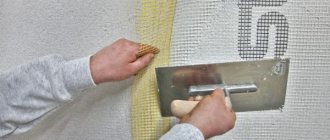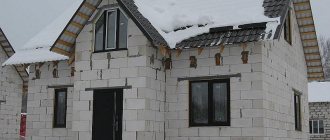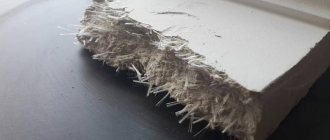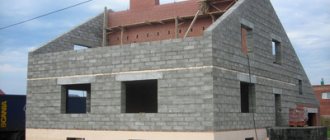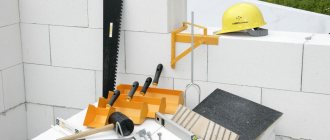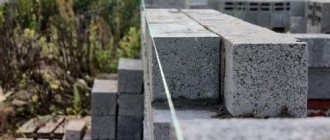Porous concrete products, including gas silicate blocks, are widely used for the construction of houses. They confidently compete with brick and stone, which have a high cost, but at the same time do not provide reliable thermal insulation and escape of vapors from the room. Gas silicate has high performance characteristics, but has a serious drawback - it cracks when bent. When constructing a wall or erecting partitions, it is important to ensure the strength of the structure. Reinforcing masonry from gas silicate blocks allows you to solve this problem.
Application, properties and characteristics of gas silicate material
When planning to build a private house or cottage from a gas silicate composite, you should carefully study the characteristics of the building material and become familiar with its properties. The blocks are made from a cement-sand mixture with the addition of water, lime and aluminum powder. When aluminum powder comes into contact with lime, a gas formation reaction occurs. The gas silicate mixture is poured into molds, where it increases in volume. The molded blocks are hardened in autoclaves, which are maintained at increased temperature and pressure. Finished products have a cellular structure.
Gas silicate blocks have increased thermal insulation properties
Depending on the concentration of air cells, the density of the gas silicate changes, affecting its area of application:
- light gas silicate blocks with a specific gravity of up to 0.2 t/m3 are used as a heat insulator;
- products with a density of up to 0.4 t/m3 are in demand in the construction of capital walls and internal partitions of low-rise buildings;
- gas silicate building material with a density of 0.5-0.7 t/m3 is used in the construction of loaded structures.
The technological process according to which gas silicate blocks are manufactured and the porous structure of the composite mass affect the properties and characteristics of the material. Gas silicate blocks are not only a modern building material with enhanced thermal insulation properties. Walls made of gas silicate allow you to maintain a comfortable temperature in the room, reducing heat loss and reducing heating costs.
In addition, block material has a range of other advantages:
- soundproofing properties. Pores evenly distributed inside the gas silicate composite effectively absorb street noise;
- frost resistance. The gas silicate composite maintains the integrity of the structure during sudden cooling with further thawing;
- harmlessness to others. Thanks to the use of environmentally friendly raw materials for the manufacture of blocks, there is no release of harmful substances;
- ease of machining. Using a standard tool, it is easy to give the desired shape to block products;
- small mass. Due to the reduced density of the material, the walls do not place additional load on the foundation;
- long period of operation. The durability of the building material is due to the peculiarities of the composite structure and resistance to rotting;
Due to its advantages, gas silicate material is in demand in construction
- increased fire resistance. Gas silicate does not collapse when exposed to temperatures up to +450 degrees Celsius for four hours;
- correct geometric shape. The clear shape of the blocks allows them to be laid using glue. A thin layer of the binder composition prevents the formation of cold bridges and allows you to save heat;
- at an affordable price. Using inexpensive building material, it is easy to reduce the estimated cost of constructing the walls of a building.
Along with advantages, gas silicate blocks also have weaknesses:
- reduced strength. Blocks are susceptible to bending forces. Block material requires reinforcement with steel reinforcement or metal masonry mesh;
- increased hygroscopicity. Through capillary channels, moisture penetrates into the gas silicate massif through the unprotected surface of the blocks, which needs additional protection.
Gas silicate material is in demand in the field of housing construction due to its range of advantages. There are proven solutions to eliminate deficiencies. Protection of gas silicate from moisture is ensured by plastering.
Increased strength is achieved by strengthening structures with masonry mesh or using reinforcement rods.
Cost of solid material
Currently, construction hypermarkets offer a wide variety of solid expanded clay concrete blocks. Particularly popular are models with a density of 1500 kg/m3. The cost of one unit of block will cost 50 rubles, while a cubic meter will cost about 3.6 thousand rubles. For this money, the client receives 20 kg of a high-quality product with frost resistance class F50.
When the density is reduced to 1 thousand kg per cubic meter, the mass of the block is reduced to 17 kilograms. At the same time, the indicators of resistance to low temperatures remain the same, and the price increases to 66 rubles per unit and 4158 rubles per cubic meter. with a density of 700 kg/m3 are also used for construction purposes . This option costs 65 rubles per piece or 4 thousand per cubic meter.
Before starting the construction of a future building or wall structure, you need not only to understand the size and number of blocks, but also to calculate the consumption of mortar for masonry work. Only after careful preparation can you go to the hypermarket and buy the required materials. In this case, the upcoming work will be successful and costs will be minimal.
More about laying corners from expanded clay blocks.
Why is it necessary to reinforce masonry from gas silicate blocks?
Despite the ability of gas silicate to withstand compressive loads, the material is susceptible to the influence of bending moments and tension. The building frame, built from gas silicate blocks, is exposed to negative factors.
Reinforcement of gas silicate blocks will prevent the impact of negative factors
The main negative aspects causing a violation of the integrity of gas silicate:
- shrinkage of the building. It occurs not only on problematic soils, but also when the foundation is weakened. As a result of shrinkage deformations, forces act in the horizontal plane. Cracks appear in gas silicate material that is not reinforced with reinforcement or mesh;
- temperature fluctuations. Under the influence of temperature changes, gas silicate blocks increase or decrease in volume. Temperature jumps cause volumetric deformations of the blocks. To strengthen them, basalt masonry mesh or metal mesh is used.
The occurrence of volumetric deformations that violate the integrity of gas silicate blocks is also influenced by the following factors:
- torques and tensile loads;
- the tendency of the material to absorb moisture;
- insufficient rigidity of the foundation;
- frost heaving of problematic soil;
- close location of aquifers.
The reinforcement of gas silicate blocks performed during the construction of building walls allows one to resist the effects of negative factors. The gas silicate is reinforced with a mesh with small cells, as well as corrugated reinforcement, which must be laid in specially prepared grooves.
Reinforcement of masonry from gas silicate blocks must be performed to solve the following problems:
- ensuring the stability of the building box;
- compensation of forces from the truss structure;
- preventing cracking of walls;
- uniform distribution of loads;
- maintaining the integrity of openings;
- increasing the safety margin of blocks under load;
- construction of gas silicate buildings in seismic zones;
- preventing volumetric deformations.
Reinforcing elements in the form of metal meshes will help increase the strength of walls
Reinforcing elements in the form of metal mesh are used not only in the construction of walls made of gas silicate blocks. Mesh reinforcement can also increase the strength of walls made of expanded clay concrete and aerated concrete blocks.
Do you need to strengthen the masonry?
According to the technological rules of GOST 32488-2013 (on wall panels with expanded clay), OST 35-26.0-86 (volumetric expanded clay concrete blocks) and STO-NO "SPKiK" -001-2015 (buildings made of expanded clay concrete), laying blocks is always accompanied by reinforcement layers.
The use of the reinforcement method is to additionally strengthen and protect the walls from cracks and increase the stability of the supports.
Reinforcement is especially important for load-bearing (structural) wall masonry , as well as the arrangement of partitions, floor slabs and the creation of an armored belt for the roof.
In addition to creating stability, reinforcement helps walls distribute the load as evenly as possible.
To strengthen the walls, rods of different lengths or a special metal construction mesh are used . These devices are called reinforcement.
Each of them performs its own function, and is often used in combination - when both rods and mesh are laid vertically and horizontally along the entire wall. For example, a metal mesh created by the manufacturer from wire is placed in the grooves of the blocks, between the adhesive composition, which are formed with a wall chaser.
Since expanded clay blocks have different shapes, work with them is carried out in different directions. Short rods are laid horizontally in hollow blocks. For full-bodied ones, long vertical rods can be used, on the sides of which masonry is arranged.
But the most common method is horizontal reinforcement , which secures the masonry every 3-4 layers of blocks. It is arranged on the surface.
A monolithic concrete reinforced belt located on top of expanded clay concrete walls is needed for point load distribution. It is 10-20 cm in height (the height of two rows of brickwork). For wall thicknesses up to 4000 mm, the armored belt is installed up to 30 cm. The reinforced devices used have a diameter of 8 to 10 mm, and the masonry joint width will be 12 mm.
Reinforcement for expanded clay concrete blocks must comply with the following regulatory requirements:
- GOST 8478-81 (about welded mesh).
- GOST 10922-90 (on types of fittings).
- SNiP 2.03.01-84 (on concrete structures).
- GOST 5781-82 (hot-rolled rod reinforcement for bulk concrete blocks).
- GOST 6727-80 (reinforcing wire).
- SNiP 2.03.11-85 (anti-corrosion requirements for fittings).
Compliance with technological rules for the selection of reinforcement and its use, as a result, guarantees a durable structure that will last for many years. Expanded clay concrete is one of the inexpensive building materials that you can work with even without special education. Therefore, securing the wall will help to obtain stable, durable masonry.
In what areas is the mesh for laying gas silicate blocks and fittings used?
Reinforcing mesh and steel rods are used to strengthen the following areas of the structure:
- the bottom row of blocks laid on the foundation base. Reinforcement elements are placed under the blocks. They allow you to evenly distribute the load on the foundation and increase the load characteristics of the first row of masonry;
- supporting surfaces of the blocks at intervals of 3-4 rows of masonry. Uniform distribution of reinforcing elements over the entire height of the main walls ensures increased resistance of the building frame to various loads;
- zones for the location of lintels in the area of window and door openings. Places where reinforced concrete lintels rest on gas silicate blocks require additional reinforcement using steel reinforcement laid in pre-prepared channels;
- the final row of gas silicate masonry, which takes the weight from the rafter structure. Using steel rods, a powerful reinforced belt is formed around the perimeter of the box, uniformly transferring loads to the load-bearing walls.
Reinforcement of gas silicate blocks with mesh and reinforcement ensures the reliability of the structures being erected, increases strength, helping to extend the service life of the structure.
Reinforcement of gas silicate blocks with mesh begins from the bottom row of blocks
Wall strengthening technology
The technology for reinforcing walls made of expanded clay blocks with rods or mesh is that the first row is always placed on a foundation on which 2 layers of waterproofing material were previously laid.
Since the first laying begins from the corner, tying the vertical seams with reinforced rods is considered mandatory.
2 rods are laid simultaneously in one seam , one of which is bent at an angle. A distance of 50 to 60 cm must be maintained between the rods.
The first layer is always made using cement-sand mortar M500 (cement or Portland cement). Other layers can be laid with glue, using jute tapes to remove cold bridges.
Reinforcement is repeated every 3-4 layers. It is especially convenient to work with a grid. It can be secured using fastening material along the surface of the wall, or simply thrown over the masonry.
The mesh is especially helpful when:
- construction of buildings on heaving soils (prevents the appearance of cracks on the walls);
- construction of buildings in a seismically dangerous zone;
- planned additional loads (2nd floor, attic);
- complex forms of masonry in the form of arches.
According to technology, it is necessary to use reinforcement for:
- first row of masonry;
- from 3 to 5 row;
- armored belt under the roof, lintels or floor slabs;
- long walls with lateral loads;
- upper edges of the pediment;
- expansion joints between the main building and the extension;
- connections with some types of insulation (composite reinforcement).
The decision on what types of reinforcement will be used in the construction is made on the basis of the drawn up project. Combined options are often used.
Installation of welded structures often requires good fastening of the frame using anchoring. A welded structure made of steel reinforcement can suffer ruptures, so when choosing this material, you need to take care of anchoring.
The mesh is always laid before applying the mortar to the blocks. The frequency of its use is determined by the building designers.
What mesh to use - metal, galvanized, fiberglass or polymer, and a specialist can also tell you its dimensions. The mesh is sold in the form of tile cards or rolls. The last type is more interesting because it is convenient to trim. Masonry mesh for reinforcement in the form of tile cards:
Mesh in rolls:
Reinforcement of gas silicate blocks with mesh: reinforcement technology
Reinforcement of walls made of gas silicate blocks is carried out in accordance with the requirements of the technological process.
According to the technology, strengthening of gas silicate masonry is carried out using various methods using the following building materials:
- corrugated reinforcement made of A-III steel with a cross-sectional size of 0.8-1 cm. Laying of metal rods for gas silicate reinforcement is carried out in special channels, the dimensions of which correspond to the cross-section of the reinforcement. The specifics of laying the rods include removing dust from the grooves and then moistening them. After laying, the reinforcing bars are coated with a binder mixture, which, after hardening, increases the strength characteristics of the masonry. To strengthen the corner sections, the reinforcing bars are bent radially and placed in the corresponding cavities;
- steel wire mesh. The diameter of the wire used to make the mesh is 0.3-0.5 cm. After spot welding, a mesh with a cell size of 4-5 cm is formed from wire blanks. The process of laying the mesh is much easier compared to installing reinforcement, since there is no need to form grooves The mesh is placed on the gas silicate surface and then completely covered with the binding solution. It is important to lay the reinforcing mesh correctly and ensure that the wire is not damaged by corrosion due to moisture.
Along with steel reinforcement and wire mesh, welded frames are also used to strengthen gas silicate structures. For their manufacture, wire with a diameter of up to 5 mm is used. The frame is a structure of two steel rods located parallel in channels, welded with wire jumpers.
To strengthen gas silicate structures, welded frames can be used instead of mesh
The general algorithm for strengthening masonry and openings with reinforcement provides:
- Surface marking.
- Making grooves.
- Cleaning and moistening the grooves.
- Cutting reinforcement.
- Laying of rods.
- Welding of elements.
- Filling the channels with solution.
The sequence of actions for mesh reinforcement is quite simple:
- Cut the mesh into segments, the width of which corresponds to the thickness of the walls.
- Lay the cut mesh on the surface of the gas silicate blocks.
- Distribute the working solution evenly over the mesh.
- Lay the next row of blocks.
It is important to follow technology when performing reinforcement work.
Difficulties and errors
The following are considered the main errors in reinforcement that lead to cracks and brittleness of walls:
- The absence of L-shaped elements made of rods in the corners of the masonry.
- The use of corroded elements that can collapse over time and leave rust in the wall, which will show through even through the finish.
- You cannot use chain-link instead of mesh, as it is not able to withstand the upper loads.
- Using a large amount of reinforcement per span. A rod on top, bottom and in the middle, or just a mesh horizontally, is enough.
- Unauthorized increase in the amount of reinforcement for the entire project.
In order to avoid mistakes, you need to strictly follow the sequence of actions specified in the project and pay attention to the condition of the materials with which you will have to work.
Vertical reinforcement of building structures made of gas silicate blocks
The need for reinforcement in the vertical plane of gas silicate walls is due to the following factors:
- increased magnitude of lateral loads;
- using gas silicate with low density;
- increased weight of the truss structure.
Vertical reinforcement technology allows:
- provide increased strength of columns made of gas silicate blocks;
- strengthen small walls and doorways in the vertical plane;
- prevent cracking of gas silicate under vertical loads.
The process of vertical reinforcement is similar to the technology of horizontal reinforcement using welded frames. To vertically strengthen gas silicate walls, it is necessary to place a pre-prepared reinforcement frame into the cavity and then fill it with a binding solution. To connect the elements of the reinforcing lattice, welding is used or the rods are connected with knitting wire.
average price
The cost of mesh for expanded clay blocks on average in the Russian Federation ranges from 32 to 87 rubles per 1 m2, and depends on the type and manufacturer. The galvanized type may cost more than the steel one. Prices vary by region.
| No. | City of the Russian Federation (region) | Cost of nets (RUB), per 1 m2 | |
| Welded | Reinforcement | ||
| 1. | Moscow | 30-45 | 80-220 |
| 2. | Novosibirsk | 30-40 | 55-90 |
| 3. | Nizhny Novgorod | 35-45 | 45-100 |
| 4. | Krasnodar | 30-40 | 50-120 |
| 5. | Khabarovsk | 35-5 | 50-150 |
The market price is unstable and constantly changing.
Preparing tools
Experts, explaining how to lay aerated concrete, recommend taking time to find the most convenient equipment:
- a carriage with a dispenser allows you to evenly apply the binder solution; a mallet is a balanced rubber hammer that facilitates the process of tamping blocks; a small saw and cutter are necessary to adjust the material to size; a sanding board solves the problem of eliminating defects in the finished surface; a trowel prevents the solution from spreading when laying the wall; a corner secures the laid elements; a plane is used to adjust and level the shape of the blocks; a wall chaser is a tool with which grooves are created; a mixer will make it easier to mix the mortar; a cord as a horizontal guide and a building level.
You will also need a container in which the mounting solution will be diluted.
Tools required for work
DIY expanded clay concrete blocks
In private construction, a building material that is becoming more and more popular every day is quite often used - expanded clay concrete blocks. Expanded clay concrete wall blocks are used in low-rise construction; they have proven themselves in the construction of dachas and cottages, garage partitions and outbuildings. A very important point is that you can make cermit concrete blocks with your own hands.
The production of expanded clay concrete blocks is not such a complicated process that can be done independently, with your own hands. Making expanded clay concrete blocks with your own hands is not only an opportunity to save money, it is also a wonderful opportunity to earn money.
It is only important to understand the block production technology, purchase raw materials for the blocks and you can get started. You can save quite a lot of money on making expanded clay concrete blocks with your own hands, and sometimes with a very limited budget, this remains the only option
In addition, in this case you can be sure of the quality of the components included in the blocks.
Related articles:
Expanded clay concrete wall blocks can be made in such a way that after the walls are laid, subsequent plaster is not even required; for this, a special textured layer is created on the surface of the blocks, but there is also a standard method, which involves the use of standard cement mortar, for production of expanded clay concrete blocks, followed by plastering of walls.
Components that will be needed for the production of expanded clay concrete blocks:
Portland cement M400 -1 part;
Expanded clay with a density of 350-500 kg/m3 (for example, the weight of such expanded clay with a fraction of 5-20 in one 10 liter bucket is 3-5 kg) - 8 parts; To create a textured layer - 0 parts;
Clean sand, fractions no more than 5 mm - 2 parts, to create a textured layer, 3 parts are required;
Water - 215-230 liters, per 1 m3, the amount of water for the textured layer must be determined by consistency, on the spot;
Sometimes special plasticizing additives are added to the expanded clay concrete mixture to improve some properties of the blocks, for example such an important parameter as frost resistance, popular additives in concrete, you can see here.
The cement mortar should be prepared in a concrete mixer; first of all, the dry components are loaded into it, after which water is added while stirring, after which everything is mixed until a homogeneous consistency. You can read more about preparing concrete mix here.
Molds for the production of expanded clay concrete blocks
When you make expanded clay concrete blocks with your own hands, you will need equipment, i.e. forms, the most commonly used are forms for blocks made of 20 mm wooden boards (inside covered with metal) or forms made of metal, connected with bolts or metal latches. The molds can be made of two L-shaped parts or 4 flat parts and of course the bottom.
The most popular sizes of expanded clay concrete wall blocks are 190x190x390 mm
For partitions, blocks measuring 80x190x390 mm are made from expanded clay concrete blocks.
Molding of expanded clay concrete blocks
Now we need to install our formwork for expanded clay concrete blocks on a flat, hard metal surface.
All walls of the resulting form, before each pouring of expanded clay concrete, must be treated from the inside with ordinary machine oil, and the base of the block must be sprinkled with sand.
Our form is filled with a solution of expanded clay concrete, after which it must be thoroughly compacted, it is advisable to do this on a vibration stand; if it is not available, it can be compacted with a metal or wooden block. Then you need to wait until the laitance begins to stand out and then level the top of the block using a trowel.
After 24 hours, you can disassemble the mold, but the blocks should not be touched or moved; they should be protected from precipitation and left to gain strength for 28 days. After a month has passed, the blocks will gain the required strength and you can begin laying walls from expanded clay concrete blocks. If you have any questions, recommendations, additions or comments to the article on how to make expanded clay concrete blocks with your own hands, leave them in the comments to the article.
Making molds
To make the blocks yourself, you can use both general formwork and several separate forms. The matrices are assembled from two side parts in the shape of the letter “L” and the tray (bottom) of the product. They can be made from a regular 20mm board, metal sheet or plastic. The standard block has dimensions 39x19x19.
It is better to fasten wooden forms with metal corners and sheathe the inside with thin-walled metal. Otherwise, they will absorb moisture from the solution, which may affect the strength of future products. If metal is not at hand, you can coat the side walls and bottom of the container with machine oil. It will also protect the matrix from moisture.
Voids in the blocks are provided not only to save mortar, but also to create air spaces in the walls to increase thermal conductivity. To create hollow products, three round or rectangular cylinders must be installed inside the molds. To prevent them from moving, they are connected to each other and then screwed with self-tapping screws to the side parts of the mold.
To obtain voids when making a small number of blocks, you can even use ordinary plastic bottles. In such cases, it is better to fill them with water to make them heavier. They must be inserted into the mold after it is 2/3 filled with the solution.
So, our forms are ready. All that remains is to prepare the expanded clay concrete.
